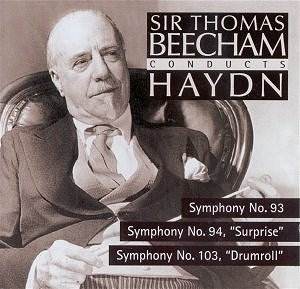Beecham conducted Haydn symphonies for fifty-five years, from
his first performance of No 103, in 1905 to his very last concert in 1960
with No 100, the Military. He was drawn to the later symphonies and never
showed much concern in performing any of the earlier except No 40 – which
he gave in a cluster of performances and recorded. Even when it came to
the London Symphonies, Nos 95 and 96 seem to have been played only for
his recording of the set in 1957/58. No 98 was rather parsimoniously dealt
with as well – the truth is that Beecham’s knowledge of Haydn was extensive
but his performances of the composer were circumscribed and so, despite
the famous recording of The Seasons, it was hardly a staple of his repertoire
and the Creation hardly at all. This selectivity was his prerogative and
in many ways his Haydn was as convincing, if not more consistently so,
than his Mozart.
These three performances shouldn’t be confused with
the Complete London Symphonies set – HMV ALP 1624/26 – which dated from
1957/58. What this Sony Classics disc has restored to the catalogue
are the American Columbia traversals of 1950/51. These are imbued with
a shopping list of virtues and one or two caveats. Of the latter it
should be noted that Beecham’s editions were of the old school and he
didn’t much care. So we get a thoroughly inauthentic pizzicato end of
No 93’s Menuetto and Trio, no repeats in the same movement or in the
similar movement in No 103. In addition to which Beecham didn’t go in
for exposition repeats at all and some of his tempi might strike one
now as sluggish. In his favour one can note the following; the trenchancy
of his phrasing, the elegance and precision of the string moulding,
the aristocracy of his music-making, the superb orchestral contributions,
the tremendous weight Beecham gives to the thematic material, the balancing
of rusticity and gentility in Haydn’s syntax, the stupendous rhythmic
life Beecham brings, the sense of momentum and control of rubato, the
particular characterisation of each movement – the list is long and
very varied.
No 93 for example is graced by broad attack in the
first movement and a trenchant working out of its development. Maybe
some aspects of phrasing in the slow movement are rather finicky, as
his later Mozart performance could occasionally be; it strikes my ear
as overnuanced and not entirely convincing. The following Minuet by
contrast – despite the loss of its repeat – is all elegance, grace and
proportion. The contrapuntal finale shows what subtlety in matters of
dynamics and timing Beecham could routinely bring - and the entirely
appropriate sonorities he cultivated were both unmistakeably his and
also indisputably Haydn’s. Is the beginning of No 94 rather too slow
– maybe. Crisp playing alleviates the suspicion somewhat as does the
boldly filigree Andante, full of Beechamesque flourishes and roulades.
Listen to the independence of the bass part in the Minuet – full of
life and animation. Sensitive sectional shaping is a cardinal virtue
of the finale to the Symphony as is superb flute playing and orchestral
playing generally. I especially admired the excellently weighted gravity
that announces the introduction of the Drumroll. Lissom strings at 3’50
are flexible and animated, Beecham managing to subsume the paragraphal
points of the music into an admirably convincing symphonic statement.
The genial and the grand co-exist in the slow movement – with gradations
of dynamics and exemplary tonal nuance. The Finale is truly con spirito,
taken with tremendous rhythmic impetus and equal orchestral clarity,
essential elements of Beecham’s music-making and treasurable features
of these remarkable performances.
Jonathan Woolf


